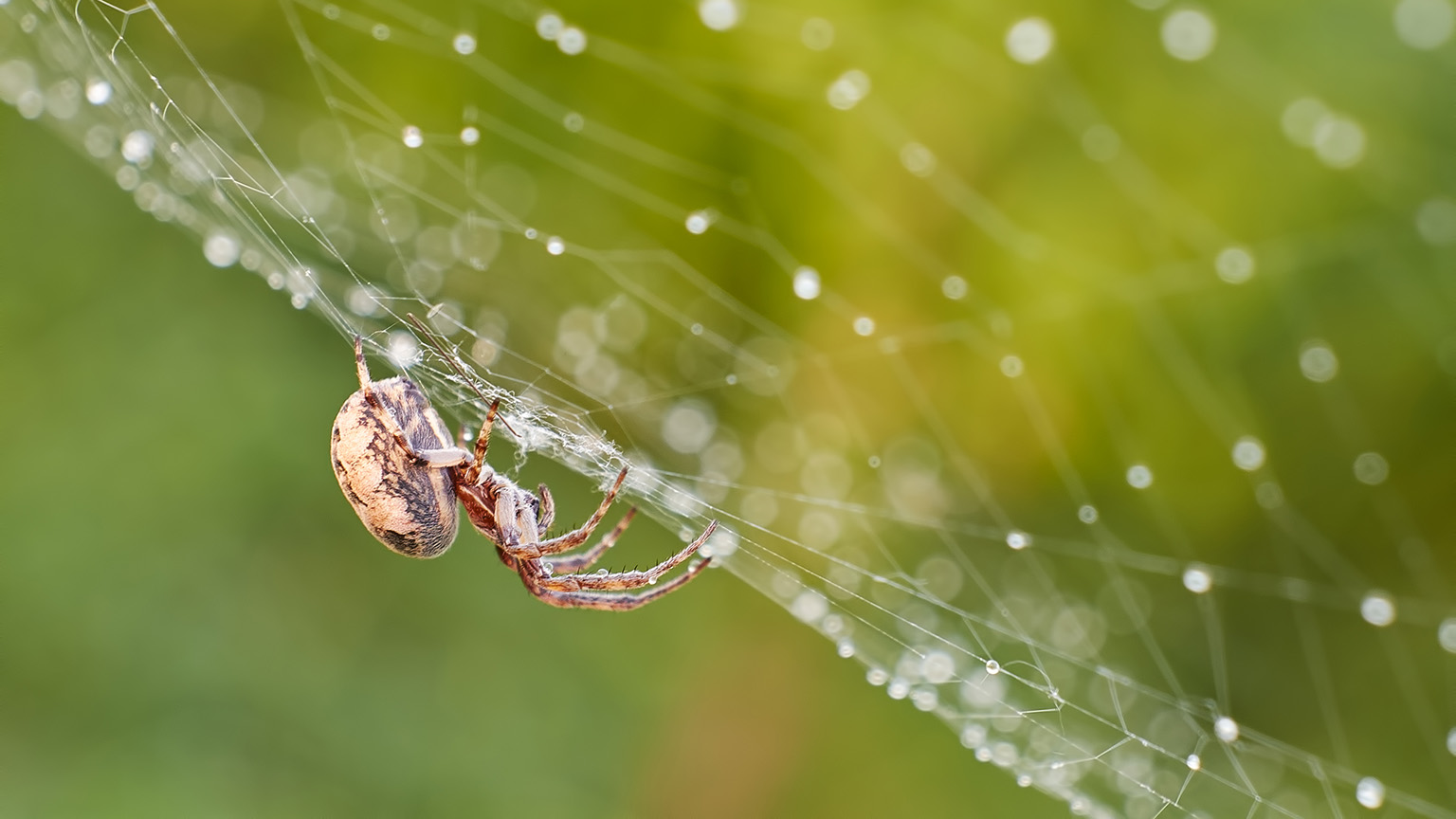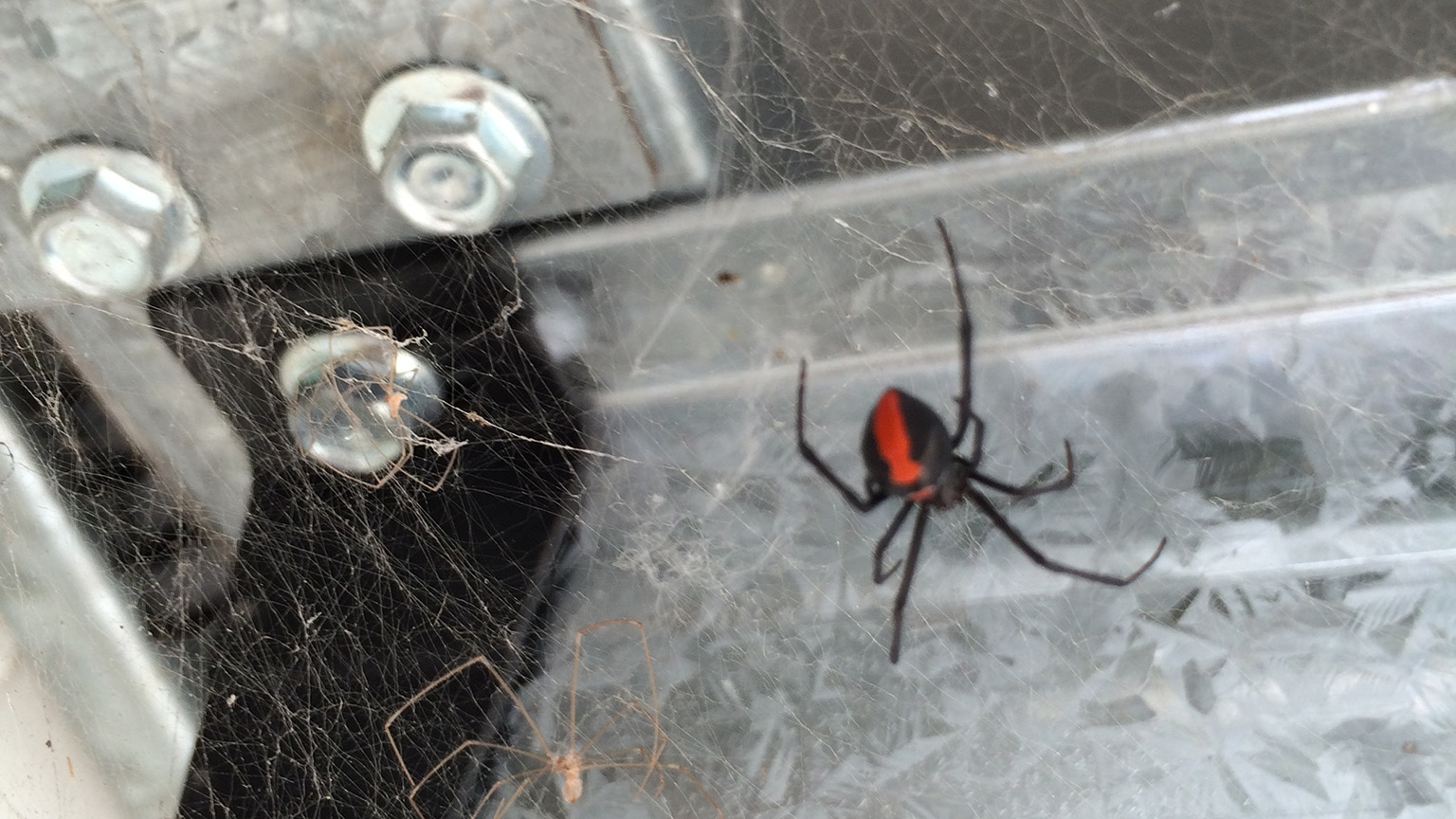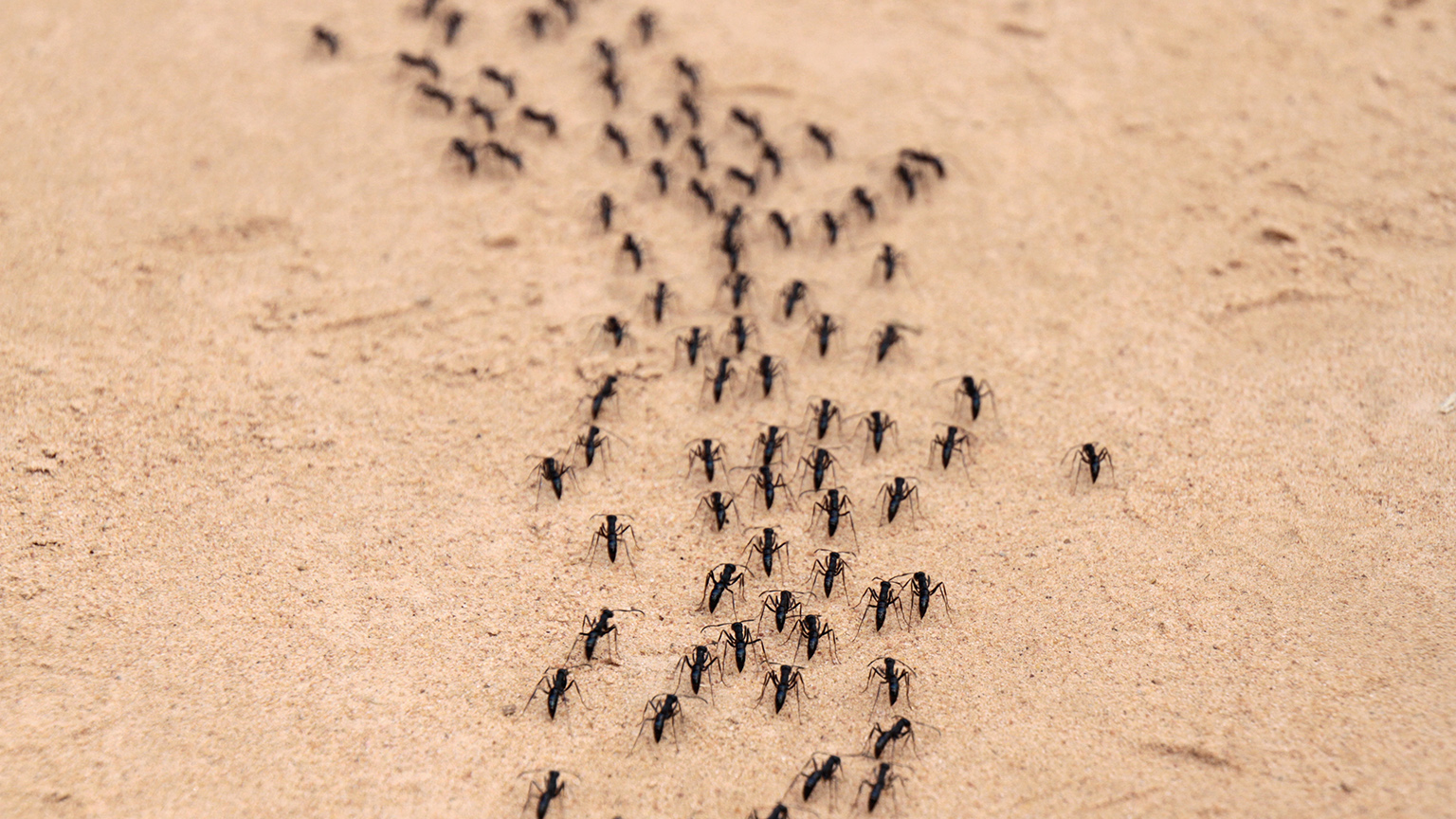Updated: July 23, 2025
Summary: Queensland homeowners can identify common spiders by examining body size, color patterns, web structure, and habitat preferences. This guide covers the six most common species found in Sunshine Coast and North Brisbane homes, helping you determine when professional pest control is needed.
Most spiders in Queensland are harmless, but knowing how to identify them can bring peace of mind. In this guide, you’ll learn simple ways to spot and recognize the six most common household spiders, plus when it’s time to call in the pros.
Why Spider Identification Matters for Queensland Homeowners
Spotted an eight-legged visitor at home? If you live in Queensland, you’re not alone. With over 52,000 spider species worldwide—and many calling Australia home—it’s no surprise that spiders occasionally show up uninvited.

Understanding spider identification isn’t just about satisfying curiosity—it’s about protecting your family and making informed decisions about pest control. Australia has about 2,000 species of spiders, but most species are relatively harmless to humans, which means the vast majority of spiders you’ll encounter pose no significant threat.
However, there’s a crucial difference between venomous and dangerous spiders. While many spiders have venom (used to subdue prey), only a few species can cause serious harm to humans. The production of effective antivenoms means there have been fewer and fewer spider bite deaths in Australia since 1980, making spider bite deaths rarer.
4 Key Reasons Why Spider Identification Matters:
- Personal safety and family protection: Knowing which spiders require immediate attention.
- Determining appropriate response measures: Understanding when to call professionals versus handling it yourself.
- Understanding when professional intervention is needed: Recognizing signs of dangerous species or infestations.
- Preventing unnecessary panic or fear: Most spiders are beneficial predators that control other pests.
When to Seek Professional Help With Your Spider Infestation
A 2021 study stated that spider bites account for 19% of venomous bite hospitalizations in Australia, with redbacks being the most common spider involved. While this statistic might sound alarming, it’s important to note that approximately 2000 people are bitten each year by Redback spiders out of Australia’s 26 million+ population, making your actual risk quite low.
The key is knowing when to be concerned and when to take action. Professional pest control becomes essential when:
- You’re dealing with dangerous species
- There are multiple spiders
- You’re unsure about identification
For comprehensive spider removal services, visit our spider removal service page.
Essential Spider Identification Basics: Key Physical Features to Examine
Successful spider identification relies on observing specific physical characteristics. Think of it like creating a spider profile—each feature provides a clue to help you determine the species.
Primary Spider Identification Features
- Body size (measured in millimeters): Use a coin or ruler for scale reference.
- Color patterns and distinctive markings: Look for stripes, spots, or unique colorations.
- Leg length relative to body size: Some spiders have disproportionately long legs.
- Web structure and placement: Different species create distinctly different web patterns.
Spider-Safe Observation Techniques
Safety should always be your priority when identifying spiders. Never attempt to handle unknown spiders with your bare hands, and maintain a safe distance during observation.
Some safe observation tools include:
- 🔦 Flashlight or phone light: Essential for examining spiders in dark corners.
- 🔎 Magnifying glass or camera zoom: Helps you see detailed markings without getting too close.
- 🪙 Measuring reference (coin or ruler): Provides accurate size assessment
- 🧤 Protective gloves if handling is necessary: Only for removing webs or relocating harmless species.
Spider Identification Documentation Methods
Taking photos can be incredibly helpful for identification, especially if you need to consult with professionals later. Focus on capturing clear images of the spider’s body, markings, and web (if present).
If you prefer not to get close to spiders at all, check out our guide on how to get rid of spiders without going near them.
Australian Spider Identification Chart: Your Guide To Queensland’s Most Common Spiders
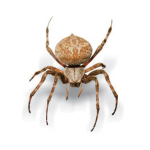
Garden Orb-Weaver Spiders (Eriophora transmarina): The Web Artists
- Physical description: These spiders are medium-sized spiders known for their large abdomen that has a leaf-like pattern and impressive circular webs.
- Size range: Males bodies range from 15-20 mm, while female bodies range between 15-17 mm.
- Colour and markings: Large abdomen with a leaf-like pattern. They can be white, dark brown, or black.
- Preferred hiding spots: These spiders can be found around homes, between lights and trees, and will hide under rocks or leaves to stay out of site.
- Danger level: These spiders are low in toxicity to humans and pets, but their bites may cause some pain, swelling, and redness.
These spiders are garden helpers, catching flying insects in their beautiful geometric webs.
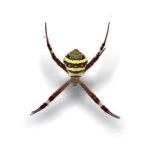
Saint Andrew’s Cross Spiders (Argiope keyserlingi): The X-Men Of Spiders
- Physical description: This spider is easily identified by the X-shaped cross displayed on their webs.
- Size range: Females can grow between 10-16 mm, while males grow between 3-4 mm.
- Colour and markings: Females sport a bright yellow abdomen while males are usually brown or cream coloured.
- Preferred hiding spots: You will usually find this spider in your garden among the leaves.
- Danger level: These spiders are low in toxicity to humans and pets. They are timid and will only bite if provoked.
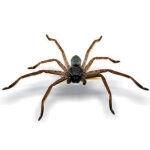
Huntsman Spiders (Heteropoda sp.): The Gentle Giants
- Physical description: These spiders are large with flattened, hairy bodies that are typically brown or gray with darker markings. These spiders have two back pairs of legs shorter than the front helping them to walk forward and sideways—similar to a crab.
- Size range: 20-30mm body length, 150-160mm leg span.
- Colour and markings: They come in a variety of colours and patterns but are usually brown, grey, or black—sometimes even white with little red patches over their mouths.
- Preferred hiding spots:Inside the home behind picture frames, under furniture, in roof spaces, or outside in forest-like areas, under woodpiles, or near wood shacks.
- Danger level: These spiders are venomous and can cause allergic reactions in rare cases to young children and pets if bitten. However, they are timid and will usually only bite if provoked.
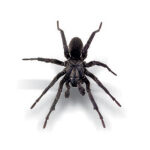
Male Trapdoor Spiders (Euoplos sp. , Arbinitis sp.): The Attacker
- Physical description: They are stubby with little hairs covering their entire body. Males have a double spur about halfway along their front legs and what can be described as small boxing gloves near their jaws.
- Size range: These spiders can grow between 15-30 mm.
- Colour and markings: Their colours range from brown to black.
- Preferred hiding spots: These spiders can be found wandering around your garden more than females because they’re looking to mate. They like warm environments and will burrow in grassy areas, hillsides, and dirt embankments.
- Danger level: Bites are low toxicity to humans and pets, but can cause localised pain and swelling.
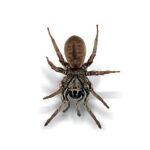
Female Trapdoor Spiders (Euoplos sp. , Arbinitis sp.): The Attacker
- Physical description: Female Trapdoor spiders are larger than males.
- Size range: Females are usually 20-30mm.
- Colour and markings: Their colours range from brown to black.
- Preferred hiding spots: Females are rarely seen wandering outside of their burrows, so if you do come across a Trapdoor spider it is most likely male.
- Danger level: Bites are low in toxicity to humans and pets, but can cause localised pain and swelling.
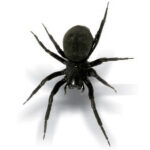
Common Black House Spiders (Badumna insignis): The Home Invaders
- Physical description: House spiders are dark, smaller spiders with pointy legs—and move quickly!
- Size range: Females can grow up to 18 mm with a 30 mm leg span. Whereas males grow to be only 10 mm but with a larger leg span in comparison to their size.
- Colour and markings: These spiders have dark brown or black legs with charcoal grey abdomens, sometimes showing a dorsal pattern of light markings.
- Preferred hiding spots: Like their name, they are found in the home, usually in cornices, around windows, or in doorways. They rarely leave their locations, so webs are usually quite messy and look tangled.
- Danger level:Their bites are low toxicity to humans and pets, but localised swelling, nausea, vomiting, and sweating can occur.
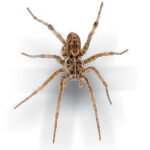
Wolf Spiders (Lycosa sp.): The Ground Hunters
- Physical description: Wolf spiders are robust, hairy spiders with excellent eyesight. They don’t build webs but actively hunt their prey on the ground.
- Size range: Wolf spiders can range in size from 10-35mm in body length.
- Colour and markings: Wolf spiders are usually brown with yellow, grey, black, or white patterns of lines across their abdomen.
- Preferred hiding spots: They are typically found in and around the garden under a silk lined burrow or loose leafs.
- Danger level: These spiders are mildly toxic to humans and pets. Their bites are painful and can cause swelling, prolonged pain, itchiness, dizziness, and nausea.
Wolf spiders are excellent pest controllers and help maintain ecological balance in your garden.
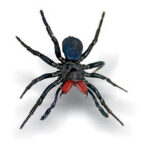
Male Mouse Spiders (Missulena sp.): The Burrow Makers
- Physical description: Male bodies are black, stout, and their legs appear quite thin.
- Size range: They can vary from 10 mm to 35 mm in length.
- Colour and markings: They can sometimes have a bright red or an orange-red jaw region.
- Preferred hiding spots: Males can be spotted more often than females around backyards in search of a mate (usually during rainy summer nights), and in gardens in small burrows. These burrows are usually closed by a trapdoor and can have parts of silk strewn out around the entrance that warn them of incoming prey. They are rarely seen east of the dividing range, but mountain ranges can be an exception.
- Danger level: Their bites are toxic to humans and pets, but are thought to use less venom or “dry bite” their victims.
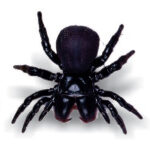
Female Mouse Spiders (Missulena sp.): The Burrow Makers
- Physical description: Female bodies are black, stout, and larger than males.
- Size range: They can vary from 20 mm to 35 mm in length.
- Colour and markings: Females usually have entire black bodies.
- Preferred hiding spots: They’re usually found in backyards and gardens in small burrows similar to males, but rarely leave their burrows. They are rarely seen east of the dividing range, but mountain ranges can be an exception.
- Danger level: Their bites are toxic to humans and pets, but are thought to use less venom or “dry bite” their victims.
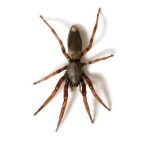
White Tail Spiders (Lampona sp.): The Wandering Predators
- Physical description: White-tail spiders are medium-sized with distinctive white markings on their abdomens. They’re nomadic hunters that don’t build webs.
- Size range: Their bodies are quite slender and can be as big as 18 mm with a leg span of 28 mm.
- Colour and markings: These spiders are most known for their whitish tip at the end of their abdomens and are usually dark reddish or grey.
- Preferred hiding spots: They can be found both inside and outside your home either under rocks and leaves, or in the folds of clothes, towels, and inside shoes.
- Danger level: These spiders are mildly toxic to humans and pets. Their bites may cause a small red or discoloured bump, swelling, itching, or burning on your skin.
While white-tail spider bites aren’t life-threatening, they can cause uncomfortable reactions in some people.
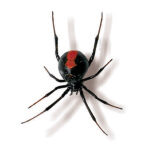
Redback Spider (Latrodectus hasselti): The Dangerous Residents
- Physical description: Redback spiders, also known as the Australian Black Widow, are small but easily recognizable by their distinctive red marking on a black abdomen. Females have spherical black bodies with a visible red line and an hourglass-shaped red/orange streak on the lower abdomen. The males are smaller and have markings along the upper side of their abdomen.
- Size range: Females 10-15mm and males 3-4mm.
- Colour and markings: Black body with distinctive red (sometimes orange) hourglass marking. Males can have either white or light brown markings along the upper side of their abdomen.
- Preferred hiding spots: They’re mostly nocturnal spiders that remain hidden during the day in dry, sheltered locations like sheds, mailboxes, and under furniture. Their webs can usually be found among rocks, in logs, shrubs, sheds, or toilets.
- Danger level: Redbacks are quite venomous and their bites may cause severe pain, localized sweating, muscular weakness, nausea, and vomiting. Be wary of anaphylaxis after being bitten by this spider. Paralysis of the lower limbs is common in severe instances.
Redback spiders pose the greatest risk to Queensland homeowners. They’re responsible for the majority of medically significant spider bites in Australia.

Male Funnel Web Spiders (Hadronyche infensa): The Moutain Climber
- Physical description: The front part of their body is usually quite glossy with less hair than the back. Males have a large mating spur located between their second pair of legs.
- Size range: These spiders’ bodies can be as long as 1-5 cm.
- Colour and markings: They are usually either black or brown.
- Preferred hiding spots: These spiders are rare throughout the Sunshine Coast although they can be found in mountain regions such as Montville and Buderim. They can be found in gardens, burrowed somewhere moist and cool. It’s common to find their burrows under rocks or in deep shrubbery. Males find themselves wandering inside homes and garages with concrete slab foundations.
- Danger level: These spiders are extremely toxic to humans and pets. Their bites result in puncture marks and localised bleeding. Symptoms such as goosebumps, sweating, and tingling around the mouth can happen within minutes.
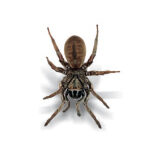
Female Funnel Web Spiders (Hadronyche infensa): The Moutain Climber
- Physical description: The front part of their body is usually quite glossy with less hair than the back. Females are more heavily built than males.
- Size range: Their bodies can be as long as 1-5 cm.
- Colour and markings: They are usually either black or brown.
- Preferred hiding spots: They can be found in and around your gardens, burrowed somewhere moist and cool. Females rarely leave their burrows, so it’s more common to see males wandering around.
- Danger level: These spiders are extremely toxic to humans and pets. Their bites result in puncture marks and localised bleeding. Symptoms such as goosebumps, sweating, and tingling around the mouth can happen within minutes.
🚩 Red Flags: When to Call Professional Help
Certain situations require immediate professional intervention. Don’t hesitate to contact pest control experts when you encounter certain spiders.
Immediate action is required when you find:
- Funnel-web spiders (though rare in Queensland, they do occur).
- Redback spiders near or in living areas, especially near children’s play areas.
- Multiple egg sacs indicate a breeding population.
- Aggressive defensive behavior—spider rears up or displays threatening posture.
- Bites or suspected bites—seek medical attention first, then professional pest control.
- Large numbers of spiders in a short time-period.
- Spiders in homes with young children, elderly residents, or individuals with compromised immune systems.
Spider infestations often indicate larger pest problems, as spiders follow their food sources. Multiple spiders in your home might mean you have underlying pest issues that require professional assessment.
Prevention & Long-Term Management: How To Create Spider-Unfriendly Environments
The best spider control starts with making your home less attractive to spiders and their prey. Here are a few helpful DIY spider prevention strategies from our professional technicians:
- Regular cleaning and decluttering
- Remove hiding spots and web-building locations
- Sealing entry points—caulk cracks, install door sweeps, and repair screens
- Outdoor lighting adjustments—use yellow bulbs that attract fewer insects
- Garden maintenance practices—keep vegetation trimmed away from your house
Seasonal Spider Considerations
Understanding seasonal spider activity helps you prepare for peak periods. Here are a few seasonal changes that you can make note of that impact the likelihood of spider infestations:
- Spring: Breeding season increases—more spiders seeking mates and nest sites.
- Summer: Peak activity periods—highest spider populations and activity.
- Autumn: Seeking shelter indoors—spiders move inside before winter.
- Winter: Reduced activity but indoor presence—spiders remain in protected areas
Good luck with your spider spotting and remember to stay safe. If you or someone you know has been bitten by one of these spiders we recommend following St. John’s DRSABCD method.
Why You Should Call The Professionals For Spider Removal
Professional pest control offers advantages that DIY methods simply can’t match. Bundilla’s Deluxe Pest Control Package offers comprehensive spider control that goes beyond simple elimination.
Our Deluxe Package includes:
- Professional spider identification: Accurate species assessment by trained technicians.
- Targeted treatment protocols: Species-specific control methods for maximum effectiveness.
- Family and pet-safe methods: Environmentally responsible pest control solutions.
- Comprehensive property assessment: Identifying and addressing attraction factors
Now that you can identify common Queensland spiders, you’re better prepared to handle them. While most are harmless, professional help offers peace of mind—especially if you’ve seen a redback or frequent sightings. Don’t wait for things to escalate—protect your home and family with expert pest control.
